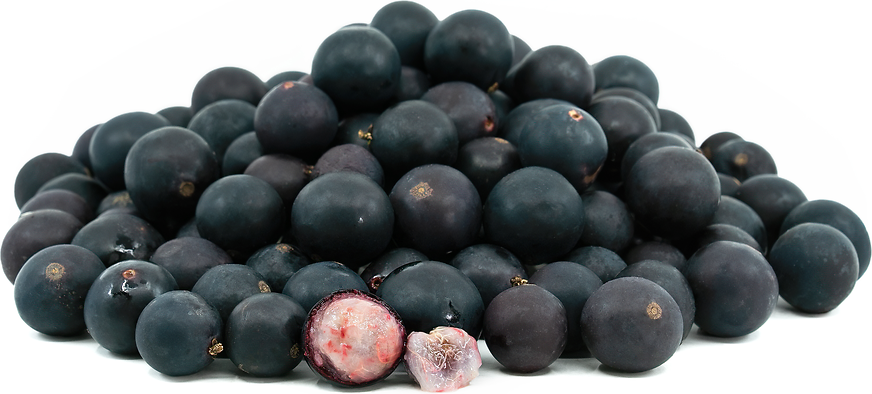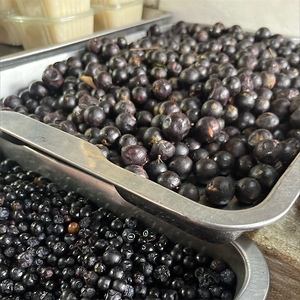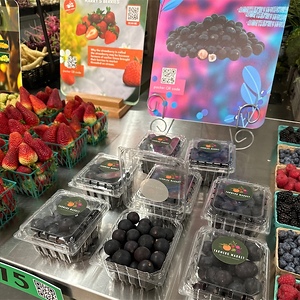


Blue Grape Berries
Estimated Inventory, lb : 0
Description/Taste
Blue Grape berries are small fruits, averaging 3 to 4 centimeters in diameter, and have a plump, round to oval shape. The fruit's skin is thick, rubbery, taut, and tough, ripening from bright green, light blue, to a dull, dark purple-blue, almost black hue when mature. The skin has a bitter, resinous, and tannic taste and is not typically consumed. Underneath the surface, the flesh is gelatinous, aqueous, and soft with a tender, succulent consistency. The translucent flesh is clear to milky white and blushed with red pigments. Some fruits will be more pigmented than others, depending on their growing environment, and typically contain 1 to 2 inedible seeds tightly adhered in the flesh by tiny fibers. Blue Grape berries release a light, fruity aroma when ripe. Select fruits that are dark in color and have turned a purple-blue. The fruits will also feel slightly soft to the touch when ripe. Blue Grape berries have a mild, sweet, floral, and subtly savory taste with nuances of muscadine grapes.
Seasons/Availability
Blue Grape berries are available year-round in tropical climates.
Current Facts
Blue Grape berries, botanically classified as Myrciaria vexator, are a rare species belonging to the Myrtaceae family. The round, pigmented fruits develop on slow-growing, evergreen trees reaching 3 to 5 meters in height and are native to tropical regions of Central and South America. Blue Grape berries are named for their slight resemblance in taste, shape, and coloring to a grape, but the species is not a type of grape and should not be mistaken for one. The fruits are also known as False Jaboticaba, Blue Jaboticaba, and Jaboticaba Azul for their similarity in flavor to Jaboticaba, another South American fruit. Blue Grape berries grow directly from the branches of the tree and may be found individually or forming in small clusters. The species is not commercially cultivated and is a rare fruiting tree often overshadowed by the well-known true Jaboticaba species. Despite their absence from commercial markets, Blue Grape berries are being produced by a few specialty growers for fresh markets as a novelty. The trees are also planted as an ornamental, favored for their showy white blooms, rounded canopy of thin branches with glossy leaves, sometimes drooping to the ground, and their peeling brown to tan-gray bark. Blue Grape trees begin to bear fruits approximately seven years after planting and are prolific in nature, producing several thousand fruits per year. The fruits are traditionally consumed as a foraged berry and are enjoyed fresh for their juicy, sweet, and tender consistency.
Nutritional Value
Blue Grape berries have not been studied for their nutritional properties. The rare fruits are a source of anthocyanins, natural compounds in the skin and flesh that give the fruits their purple-red hues. Anthocyanins have antioxidant-like properties to protect the cells against the damage caused by oxidative stress and free radicals. Anthocyanins also have anti-inflammatory and antimicrobial properties to protect the body's overall health.
Applications
Blue Grape berries have a sweet, fruity, and subtly savory taste suited for fresh and cooked preparations. The fruits are popularly consumed straight out of hand and are enjoyed for their soft, tender flesh. It is important to note that the skin and seeds are not eaten, and the flesh is traditionally sucked from the skin. The flesh is also popped whole into the mouth, and the seeds are spit out. Another method of removing the flesh from the skin is squeezing the flesh out using the thumb and forefinger. Blue Grape berries are popularly added to juices, smoothies, and other beverages or fermented into liquors and wine. The fruits are also simmered into jams, jellies, and other preserves or cooked into a mild syrup for drinks and desserts. Blue Grape berries pair well with dark chocolate, vanilla, white wines, and fruits such as apples, citrus, and pears. Whole, unwashed Blue Grape berries dehydrate and ferment quickly once harvested. The fruits should be immediately consumed for the best quality and flavor and will only keep for 1 to 3 days after harvesting.
Ethnic/Cultural Info
In Venezuela, Blue Grape berries are found in Ramsar Sites, also known as Wetlands of International Importance. Ramsar Sites are designated areas of land managed by the Convention of Wetlands, one of the oldest intergovernmental treaties created by countries worldwide, established in the 1960s. The treaty was designed to protect natural habitats that were disappearing due to deforestation and urbanization, and the convention was later adopted by the Iranian city of Ramsar in 1971, giving the protected sites its name. There are over 2,000 Ramsar Sites worldwide, and Venezuela has five protected areas of wetlands registered with the convention. In addition to its conservation efforts, Venezuela is known as the Land of Grace. Legend has it that the country received this nickname from Christopher Columbus when he viewed the land from the shoreline and saw the vast abundance and diversity of the region. Venezuela is known for its distinct habitats and contains regions filled with tropical rainforests, where Blue Grape berries are found, to mountainous areas with icy glaciers.
Geography/History
Blue Grape berries are native to Central and South America and have been growing wild since ancient times. Much of the species' history is unknown, as the plant has remained primarily wild, but it has been identified in tropical to subtropical regions throughout Venezuela, Panama, Costa Rica, and Ecuador. The species is also featured in the Summit Botanic Gardens outside of Panama City in Parque Nacional Soberania, where it has been studied on a small scale. Blue Grape berries thrive in warm, sunny locations and are often seen growing along roadsides and at the edge of pastures and forests. The species is also found in some coastal areas. In the modern day, Blue Grape berries are not commercially cultivated and are mostly grown in home gardens as ornamental landscapes. A few specialty growers cultivate the species for sale in fresh markets and farmer's markets. When in season, the fruits can be foraged from wild or cultivated trees in select areas of South America, Central America, and Southern Florida.









